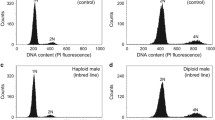Abstract
The identification of recombinant males inMuscidifurax raptorellus Kogan & Legner, secured from virgin hybrid ♀♀ formed by crossing cohorts from solitary and gregarious, populations, supports chromosomal inheritance of gregarious oviposition behavior. Examination of parasitization behavior in female progeny that had recombinant male fathers, indicated the, existence of recombinant ♂♂. Such ♂♂ also were able to elicit immediate phenotypic changes in their female mating partners, at intensities expected from their genetic character, as previously observed with original parental ♂♂ in this species. Progeny originating from F1 mothers and recombinant fathers demonstrated the highest levels of heterosis, as measured by increased parasitization rates and numbers of eggs laid. Although extranuclear inheritance has not been eliminated, its influence on phenotypic changes in progeny seems minimal.
Résumé
L'identification de ♂♂ recombinants deMuscidifurax raptorellus Kogan & Legner, issus de ♀♀ vierges descendantes de croisements entre populations grégaires et solitaires, a permis la mise à jour d'un déterminisme génétique chromosomique du comportement de grégarité. L'analyse de ce comportement dans la descendance de femelles croisées avec ces ♂♂ recombinants indique également la présence de tels ♂♂. Ces ♂♂ présentent de plus la capacité de provoquer des changements phénotypiques immédiats chez leur partenaire sexuel, et ce avec une intensité en accord avec leurs caractéristiques génétiques, comme ceci a pu être observé chez les ♂♂ de la souche parentale. La descendance issue de croisements entre ♀♀ F1 et ♂♂ recombinants présente un niveau élevé d'hétérosis se traduisant, par une augmentation à la fois du taux de parasitisme et du nombre d'œufs pondus. Bien que l'existence d'un déterminisme extra-chromosomique n'ait pu être écartée; son éventuelle influence sur le phénotype de la descendance semble limité.
Similar content being viewed by others
References
Corbet, S. A. — 1985. Insect chemosensory responses: a chemical legacy hypothesis. —Ecol. Entomol., 10, 143–153.
Crozier, R. H. — 1971. Heterozygosity and sex determination in haplodiploidy. —Am. Nat., 105, 399–412.
Crozier, R. H. — 1975. Animal Cytogenetics 3, Insecta 7 Hymenoptera. —Berlin Gebruder Borntraeger, 95 pp.
Duncan, D. B. — 1955. Multiple range and multiple F tests. —Biometrics, 11, 1–41.
Kawooya, J. K. — 1983. Electrophoretic discrimination of species of theMuscidifurax [Hymenoptera: Pteromalidae] complex. —Ph. D. Dissertation, Univ. of Illinois, Urbana, 113 pp.
Legner, E. F. — 1987. Inheritance of gregarious and solitary oviposition inMuscidifurax raptorellus Kogan & Legner [Hymenoptera: Pteromalidae]. —Can Entomol., 119, 791–808.
Legner, E. F. — 1988a.Muscidifurax raptorellus [Hymenoptera: Pteromalidae] females exhibit post mating oviposition behavior typical of the male genome. —Ann., Entomol. Soc. Am., 81, 524–527.
Legner, E. F. — 1988b. Quantitation of heterotic behavior in parasitic Hymenoptera. —Ann. Entomol. Soc. Am., 81, 567–681.
Legner, E. F. — 1988c. Hybridization in principal parasitoids of synanthropic Diptera: the genusMuscidifurax [Hymenoptera: Pteromalidae]. — Hilgardia, 56, 4, 36 pp.
Legner, E. F. — 1989a. Wary genes and accretive inheritance in Hymenoptera. —Ann. Entomol. Soc. Am., 82, 245–249.
Legner, E. F. — 1989b. Paternal influences in males of the parasitic wasp,Muscidifurax raptorellus Kogan & Legner [Hymenoptera: Pteromalidae]. —Entomophaga, 34, 307–320.
Legner, E. F. — 1989c. Phenotypic expression of polygenes inMuscidifurax raptorellus [Hym.: Pteromalidae], a synanthropic fly parasitoid. —Entomophaga, 34, 37–44.
Legner, E. F. — 1991. Estimations of the number of active loci, dominance and heritability in polygenic inheritance of gregarious behavior inMuscidifurax raptorellus Kogan & Legner [Hymenoptera: Pteromalidae]. —Entomophaga, 36, 3–20.
Metcalf, R. A., Marlin, J. C. &Whitt, G. S. — 1975. Low levels of genetic heterozygosity in Hymenoptera. —Nature, 257, 792–794.
Steel, R. G. D. &Torrie, J. H. — 1980. Principles and Procedures of Statistics, 2nd Edition. —McGraw-Hill Book Co., Inc., New York.
Author information
Authors and Affiliations
Rights and permissions
About this article
Cite this article
Legner, E.F. Recombinant males in the parasitic waspMuscidifurax raptorellus [Hymenoptera: pteromalidae] . Entomophaga 36, 173–181 (1991). https://doi.org/10.1007/BF02374553
Received:
Accepted:
Issue Date:
DOI: https://doi.org/10.1007/BF02374553




